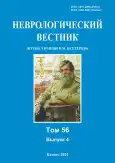Группы риска развития интернет-зависимости
- Авторы: Сидоров А.А.1, Солдаткин В.А.1, Кибитов А.О.2,3
-
Учреждения:
- Ростовский государственный медицинский университет
- Национальный медицинский исследовательский центр психиатрии и неврологии им. В.М. Бехтерева
- Первый Санкт-Петербургский государственный медицинский университет им. И.П. Павлова
- Выпуск: Том LVI, № 4 (2024)
- Страницы: 355-367
- Раздел: Оригинальные исследования
- URL: https://journal-vniispk.ru/1027-4898/article/view/281617
- DOI: https://doi.org/10.17816/nb629858
- ID: 281617
Цитировать
Аннотация
Обоснование. С учётом редкости литературных данных об отличиях групп игровой зависимости (ИЗ) и преимущественного рассмотрения их особенностей лишь в ключе одной из форм (азартной или игровой) представляется актуальным исследование личностных, психологических, морфофункциональных, генетических и других особенностей пациентов в контексте сравнения форм ИЗ для разработки адресных программ профилактики. Результатом тщательного подхода к изучению конкретных свойств пациентов со сформированной ИЗ или с риском формирования ИЗ является создание эффективных социально-психологических, психолого-педагогических превентивных программ, а также совершенствование психотерапевтических подходов в работе с такими категориями пациентов.
Цель. Создание алгоритма дифференцированной оценки риска формирования интернет-зависимости.
Материалы и методы. Изучение клинико-психопатологических, клинико-динамических, психологических, психометрических особенностей и факторов риска развития интернет-зависимости проводилось в рамках открытого исследования 69 пациентов с ИЗ: из них у 39 была игровая форма (ИЗ-ИФ), у 30 — азартная (ИЗ-АФ). Контрольная группа (КГ) представлена 40 условно-здоровыми добровольцами. В качестве основных методов исследования применяли клинический, психологический и психометрический, в качестве дополнительного — генетический. Статистическую обработку данных проводили с использованием критериев Шапиро–Уилка, Колмогорова–Смирнова, t-критерия Стьюдента, t-критерия Уэлча, U-критерия Манна–Уитни.
Результаты. Впервые в контексте сравнения двух ключевых форм ИЗ (ИЗ-ИФ и ИЗ-АФ) проанализированы данные о личностных, морфофункциональных и половых особенностях пациентов с ИЗ. Выявленные характеристики рассмотрены с точки зрения риска развития зависимости как в целом, так и дифференцированно, в отношении различных форм интернет-аддикции. На основе анализа полученных данных разработаны математические модели, оценивающие риск развития интернет-зависимости в целом и её отдельных форм, что позволяет определить группы риска и уточнить профилактические мероприятия.
Заключение. Создан алгоритм дифференцированной оценки риска формирования интернет-зависимости.
Полный текст
Открыть статью на сайте журналаОб авторах
Алексей Алексеевич Сидоров
Ростовский государственный медицинский университет
Автор, ответственный за переписку.
Email: alexe7890@mail.ru
ORCID iD: 0000-0001-6039-4089
SPIN-код: 9655-6360
Россия, Ростов-на-Дону
Виктор Александрович Солдаткин
Ростовский государственный медицинский университет
Email: sva-rostov@mail.ru
ORCID iD: 0000-0002-0222-3414
SPIN-код: 8608-9020
д-р мед. наук
Россия, Ростов-на-ДонуАлександр Олегович Кибитов
Национальный медицинский исследовательский центр психиатрии и неврологии им. В.М. Бехтерева; Первый Санкт-Петербургский государственный медицинский университет им. И.П. Павлова
Email: druggen@mail.ru
ORCID iD: 0000-0002-8771-625X
SPIN-код: 3718-6729
д-р мед. наук
Россия, Санкт-Петербург; Санкт-ПетербургСписок литературы
- Digital 2019: Global Overview Report. Режим доступа: https://wearesocial.com/blog/2019/01/digital-2019-global-internet-use-accelerates Дата обращения: 03.06.2024.
- Барышева Ю.С. Социализация и инкультурация российских детей и подростков в цифровой среде: основные проблемы и исследования // Вестник Московского государственного лингвистического университета. Гуманитарные науки. 2022. № 1. С. 166–176. EDN: ESGETY doi: 10.52070/2542-2197_2022_1_856_166
- Бухановский А.О., Андреев А.С., Бухановская О.А. Зависимое поведение: клиника, динамика, систематика, лечение, профилактика: пособие для врачей. Ростов-на-Дону: Феникс, 2002.
- Киселева А.Э. Маркетинговые манипуляции и аддиктивные технологии — вирус современности // Chronos: экономические науки. 2021. Т. 6, № 1. С. 18–21. EDN: DZCHTE doi: 10.52013/2712-9713-29-1-5
- Короленко Ц.П., Дмитриева Н.В. Психосоциальная аддиктология. Новосибирск: Олсиб, 2001. EDN: WEQAYD
- Солдаткин В.А., Дьяченко А.В., Мавани Д.Ч. Концепции формирования компьютерной зависимости // Социальная и клиническая психиатрия. 2013. Т. 23, № 3. С. 104–110. EDN: RAHEAV
- Мигунова Ю.В. Особенности влияния виртуального пространства на современную молодежь // Теория и практика общественного развития. 2021. № 11. С. 51–55. EDN: LRBEMC doi: 10.24158/tipor.2021.11.6
- Реброва О.Ю. Описание процедуры и результатов статистического анализа медицинских данных в научных публикациях. В кн.: Рекомендации по подготовке научных медицинских публикаций / под ред. С.Е. Бащинского, В.В. Власова. Москва: Медиа Сфера, 2006. С. 94–105.
- Ланг Т., Альтман Д. Основы описания статистического анализа в статьях, публикуемых в биомедицинских журналах. Руководство «Статистический анализ и методы в публикуемой литературе (САМПЛ)» // Медицинские технологии. Оценка и выбор. 2014. № 1. С. 11–16. EDN: TIXQTT
- Александровский Ю.А. Пограничные психические расстройства. Москва: Медицина, 2000. EDN: VUJAGX
Дополнительные файлы








